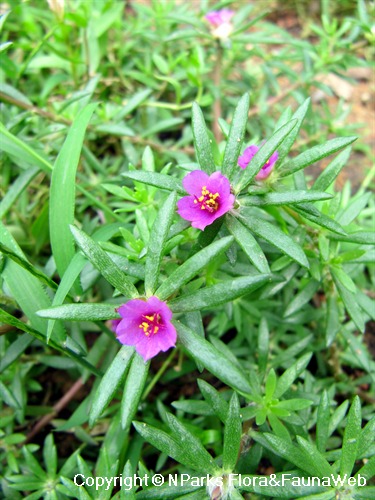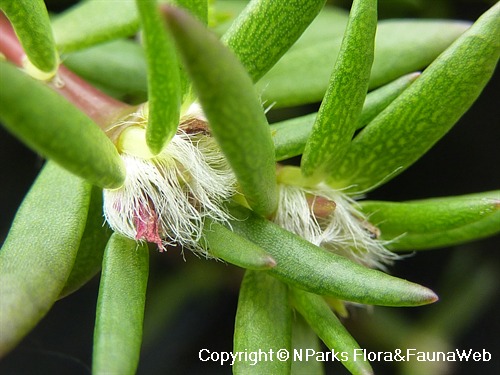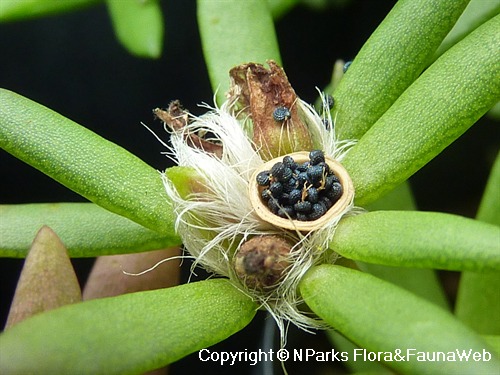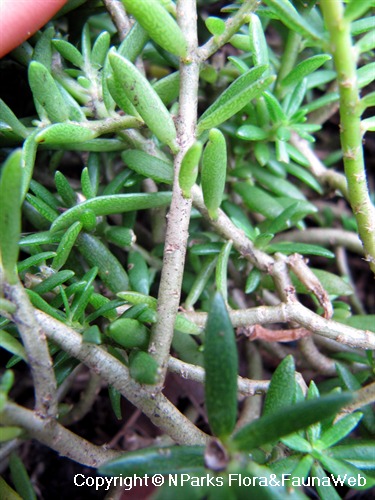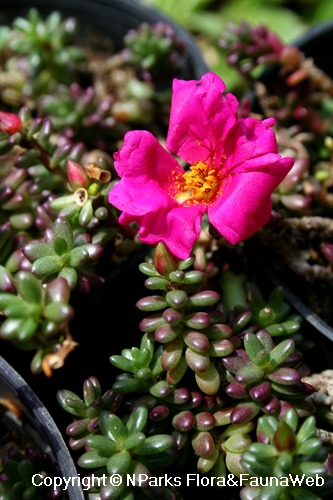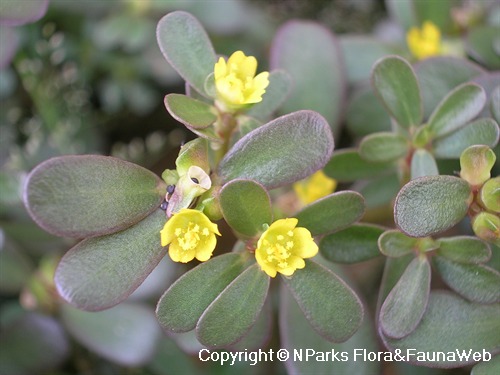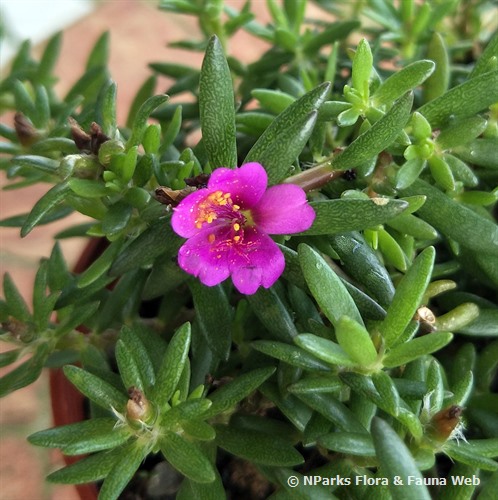
Back
Portulaca pilosa L. var. pilosa
| Family Name: | Portulacaceae |
| Common Name: | Rose-Flowered Purslane, Penawar, Pigweed, Pink Purslane, Kiss Me Quick, Shaggy Portulaca, Hairy Portulaca, Seashore Purslane |
Name
Classifications and Characteristics
| Plant Division | Angiosperms (Flowering Seed Plants) (Dicotyledon) |
|---|---|
| Plant Growth Form | Succulent Plant, Creeper |
| Lifespan (in Singapore) | Annual |
| Mode of Nutrition | Autotrophic |
Biogeography
| Native Distribution | Pantropical |
|---|---|
| Native Habitat | Shoreline (Sandy Beach, Rocky Beach) |
| Preferred Climate Zone | Tropical |
| Local Conservation Status | Non-native (Spontaneous (Naturalised)) |
Description and Ethnobotany
| Growth Form | It is a creeping herb. |
|---|---|
| Foliage | Its spirally arranged, unstalked leaves have fleshy leaf blades that are drop-shaped to linear, flattened, and 0.4–2.8 by 0.05–0.4 cm. |
| Flowers | Its flowers are surrounded by bracteoles and covered with hair. Each flower has 4–6 petals that are pink and 2–6 sepals. This subspecies is split into three races - pilosa, tuberosa, and filifolia. Races pilosa and tuberosa are recorded to occur in Singapore. Race pilosa has pink flowers and has a pantropical distribution (excluding Australia). It is found locally at Pulau Ubin. Race tuberosa has yellow flowers and is found in East Asia, Malesia and West Pacific. It is found locally at Pulau Sejahat and the southern islands. |
| Fruit | Its fruits are egg-shaped, round or drop-shaped, shiny straw-yellow to olive-green and 0.2–0.4 cm in diameter. Each fruit contains oval seeds that are dull light to dark grey or bluish and 0.04–0.07 cm in diameter. |
| Habitat | It grows in coastal areas. It occurs locally in Pulau Pawai. |
| Associated Fauna | Its flowers are pollinated by insects. |
| Cultivation | It can be propagated by seed or stem cutting. |
| Etymology | Latin porto, carry; Latin lack, milk, referring to juicy nature of the plant; Greek pilosa, pili or covered with hair, referring to the plant’s stem |
| Ethnobotanical Uses | Medicinal: It is used as a medicinal herb for treatment of boils in the groin in Malay folk medicine. |
Landscaping Features
| Landscaping | It may be suitable for parks and coastal areas as a groundcover in full sun areas with well-draining soil. |
|---|---|
| Landscape Uses | Parks & Gardens, Small Gardens, Coastal, Beachfront / Shoreline, Flowerbed / Border, Groundcover, Container Planting, Suitable for Hanging Baskets |
Fauna, Pollination and Dispersal
| Pollination Method(s) | Biotic (Fauna) (Insects (Bee)) |
|---|---|
| Seed or Spore Dispersal | Abiotic |
Plant Care and Propagation
| Light Preference | Full Sun |
|---|---|
| Water Preference | Little Water |
| Plant Growth Rate | Fast |
| Rootzone Tolerance | Drought Tolerant, Moist Soils, Well-Drained Soils, Saline Soils / Salt Spray, Easy to Grow |
| Transplanting Tolerance | Good |
| Maintenance Requirements | Moderate |
| Propagation Method | Seed, Stem Cutting (Tip, Herbaceous) |
Foliar
| Foliage Retention | Evergreen |
|---|---|
| Mature Foliage Colour(s) | Green |
| Mature Foliage Texture(s) | Smooth, Thick |
| Foliar Type | Simple / Unifoliate |
| Foliar Arrangement Along Stem | Spiral |
| Foliar Attachment to Stem | Sessile |
| Foliar Shape(s) | Non-Palm Foliage (Obovate, Linear) |
| Foliar Margin | Entire |
Floral (Angiosperm)
| Flower & Plant Sexuality | Bisexual Flowers |
| Flower Colour(s) | Pink, Yellow / Golden |
|---|---|
| Flower Grouping | Solitary |
| Flower Location | Terminal |
| Flower Symmetry | Radial |
Fruit, Seed and Spore
| Mature Fruit Colour(s) | Brown |
|---|---|
| Fruit Classification | Simple Fruit |
| Fruit Type | Dehiscent Dry Fruit |
References
| References | Sivarajan, V.V. (1981). Taxonomic notes of the genus Portulaca Linn. in India, Journal of the Bombay Natural History Society 78(2): 259. |
|---|
Image Repository
Others
| Master ID | 30295 |
|---|---|
| Species ID | 4604 |
| Flora Disclaimer | The information in this website has been compiled from reliable sources, such as reference works on medicinal plants. It is not a substitute for medical advice or treatment and NParks does not purport to provide any medical advice. Readers should always consult his/her physician before using or consuming a plant for medicinal purposes. |

